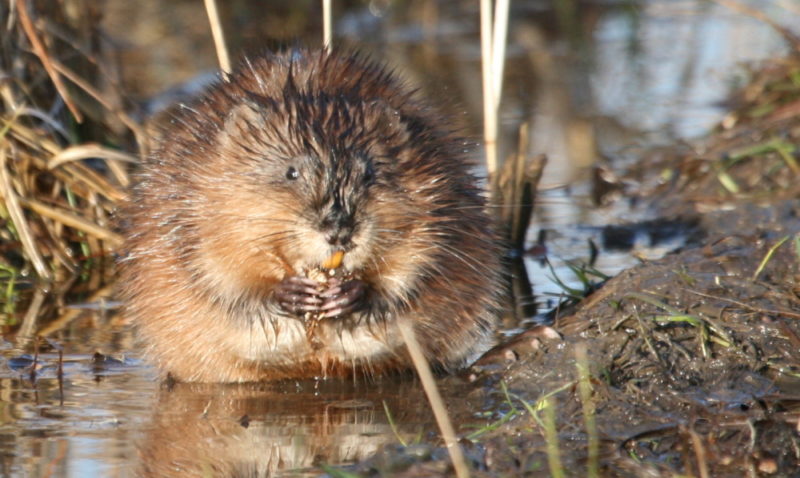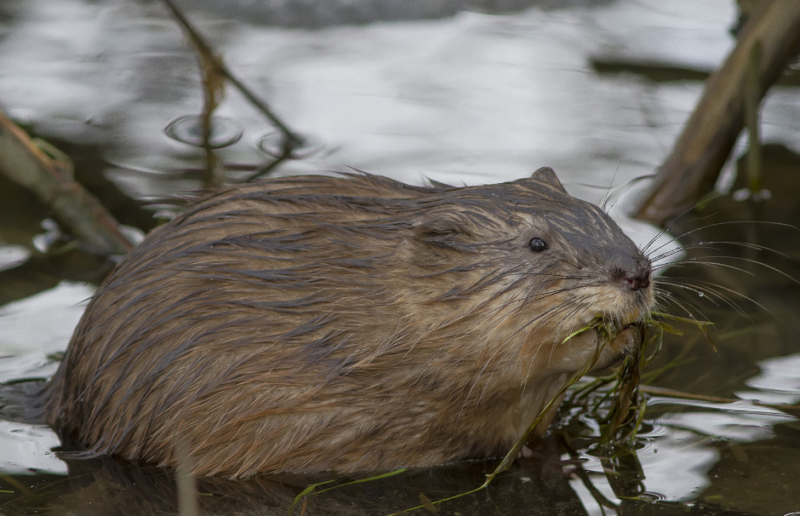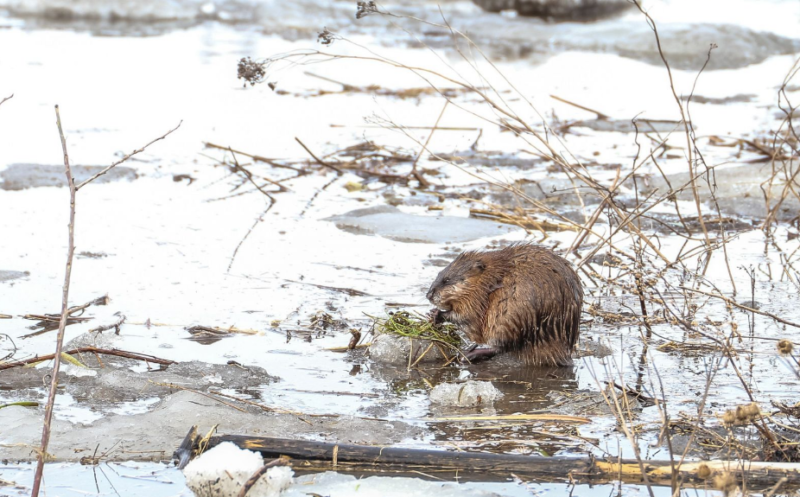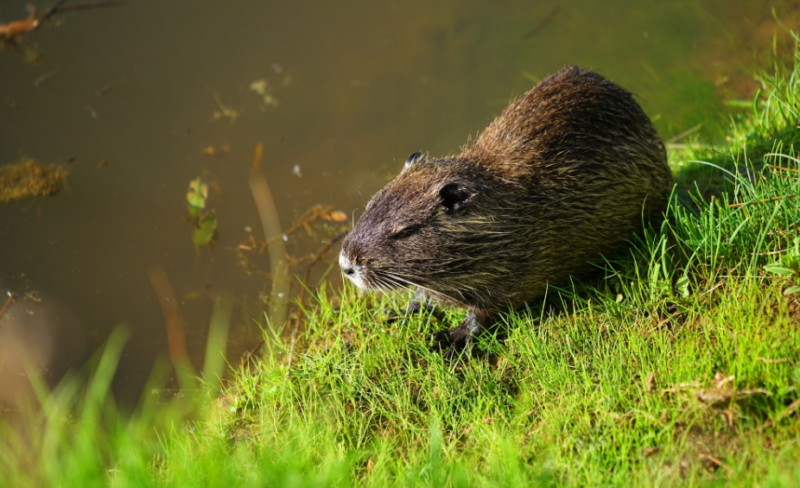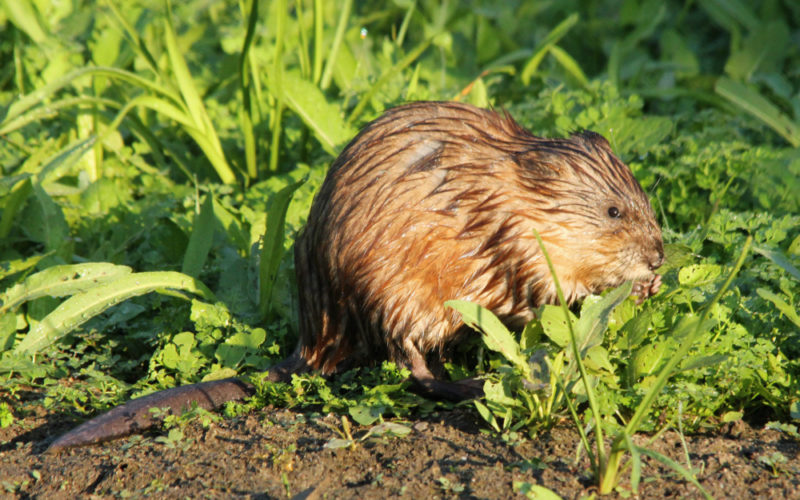In this publication we will talk about what kind of muskrat animal. The animal was introduced to Europe in the 30s of the last century for breeding into fur, which is very valuable, and it quickly spread, despite the extermination. Due to their appearance, the muskrat is often confused with the otter, but these are completely different species.
Material Content:
What does a muskrat look like
The animal belongs to rodents, very large and cute. The length of his body with his tail ranges from 0.4 to 0.6 m, and the weight, regardless of the availability of feed, can be from 700 grams to 2 kilograms.
The fur coat of the muskrat is luxurious, has a color from light brown to brown, it is it that is the reason for the rodent hunting, covers the whole body, but the tail is completely furless. Nature deliberately left him bald, because thanks to this, heat exchange processes occur faster, which is very important, because the animal spends most of its time in water.
And the tail is a store of provisions, like a camel's hump. It stores fat, which supports the viability of the rodent during the hungry winter months.
The muskrat is believed to be the ancestor of rats that have evolved for easier swimming.
- The body of the animal is elongated, there are membranes on the legs, and the tail is slightly flattened (of course, not like the beaver, but still makes swimming easier).
- Light muskrats have also changed - thanks to the evolution of the organ, the beast can be under water for up to 20 minutes.
- The undercoat is dense, water-repellent. Thanks to the sebaceous glands that enrich the fur with fat, the muskrat does not freeze even in cold water.
- The head of the rodent is small in size, elongated.Button eyes are set high, which allows you to view the territory for the presence of enemies, almost without floating out from under the water.
- The ears are neat, tightly pressed to the head, this prevents them from freezing in the winter days.
- The peculiarity of the structure of the mouth of the muskrat is that the incisors pass through the upper lip. This allows the animal, without choking water, to nibble vegetation at a depth.
- In the nostrils there are special muscles that tightly close when the rodent is submerged under water, and this prevents the liquid from entering the respiratory tract.
- There is a lot of hemoglobin in the blood, and this allows you to saturate the body with oxygen while prolonged exposure to under water.
Now you know what the muskrat looks like. But this is too early to complete the description of the species. Consider his habits, lifestyle and other useful information.
Habitat
The animal appeared in North America, and is distributed to this day there almost throughout the mainland. At the beginning of the 20th century, the rodent was brought to Eurasia, it multiplied rapidly, and today it is found on many rivers, ponds, and lakes.
If the bottom of the reservoir is rich in silt and the remains of aquatic vegetation, then the muskrat is certainly found in it. This animal builds huts - nesting holes in which it lives and reproduces for a long time. Another important biotope criterion is that the pond does not freeze in winter. Minks of animals are located 50 cm from each other, and rodents live in families in them. The musky rat densely populates the territory, and up to 6 families can live on one hundred parts. In winter, when it is very cold, you can find additional muskrat shelters built from snow, ice and dry plants.
The muskrat burrows are spacious, dug on land in the rhizomes of trees closely adjacent to the pond. The inside is always covered with dry grass, and the entrance is located closer to the water and even under water, from where predators cannot get. The huts are divided into compartments: a rest and sleep area, pantries for preserving supplies for the winter.
Lifestyle and habits
The river muskrat densely populates the coastal zones of water bodies. Rodents zealously guard their territory from strangers, males mark the territory with a sharply smelling secret. If strangers enter the zone, real fights begin, in which the head of the family defends his right to live in the designated place. If the population density is too high, and the musky rat does not have enough food, then she can eat her relatives.
In the fall, muskrats begin to build additional storage facilities for provisions adjacent to the main hut. These stores will allow you to live the winter without hunger, and are created from silt and aquatic plants. In the spring, with the onset of floods, the pantries are washed away, but by autumn there will be new ones.
The animals are very active, you can meet them at any time of the day. Usually, rodents begin to work and get food in the morning and after sunset. In the afternoon, muskrats sleep and bathe.
The period of weddings in musk rats begins with the onset of the first warm spring days. Males look after their pregnant wife, they build warm nests together. The female can bring offspring three times before the fall. The mother carries the babies for a month, and then feeds them milk for a month. The male takes an active part in the upbringing of the young, and from 8 to 9 weeks of their life he takes full care of himself.
Offspring in the amount of 2 to 8 babies are born devoid of hair, blind, and one rodent weighs no more than 25 grams. By two months of life, muskrats are already completely independent, the father begins to teach them all the tricks of building nests, pantries, and finding food.
Power Features
In nature, musky rats settle in areas with abundant vegetation, where the depth of the reservoir does not exceed 2 meters, because these are the most favorable conditions for the growth of the main type of food of the rodent. The muskrat eats reed, horsetail, duckweed, cattail, calamus, reed and sedge.
Rodents almost do not eat fish; due to a lack of plant foods, mollusks, insects, and frogs can enter the diet.
With home content, you need to bring the menu as close to natural as possible. To diversify the diet allow cereal cereals, eggshells, animal feed, root vegetables, vegetables and fruits.
Muskrats eat almost without ceasing in the warm season. Thus, they accumulate fat for the winter, so as not to die from cold and hunger. You can often see how the muskrat, lying on its back on the surface of the water, gobbles up a juicy reed. A rodent and a rodent to constantly chew something!
Population and species status
Despite the fact that the musk rat is an object of hunting, its population is stable, independent of humans. Muskrats multiply quickly, and extermination does not threaten them.
The species is not protected, it is allowed to hunt in the fall, because at this time there are almost no pregnant females, the offspring appear in spring and summer. The animal is not included in the list of endangered species, and its main enemy is not people, but predators who like to eat rodents.
Life span
The muskrat animal in natural conditions rarely lives up to the age of three. Young animals often die from cold and hunger in the first year of their lives.
In captivity, the musk rat has a longer life - up to 10 - 12 years. Of course, for a pet to please his presence for many years, he needs to ensure proper care.
How muskrats winter
The musky rat hibernates in the hut, which was built all summer and autumn. It does not fall into hibernation, eats during the cold months, and does not leave the nest. Young growth, born this year, lives with parents only the first winter. In the spring, the female cubs kicks out, and they begin to equip their own housing (good, the father taught).
During winter, muskrats often die, especially for inexperienced individuals who first built a hut. It may not be dense, and during the winter thaw it is flooded with water.
Human interaction
In the places where muskrats live, people breed whole households. The hunters help rodents to equip the huts in the most difficult places, for this, rafts made of reed or other plants are built, then the muskrat itself will build a dwelling from the base. But not only in the wild, does a man breed a musky rat - they create farms for breeding this fur-bearing animal, where they are specially raised for fur.
It is possible to contain a muskrat at home. This is a very cute, funny and affectionate pet. She is smart, active, will be in contact with a person.
In order for the animal to feel good, live long and not get sick, he needs to create special conditions:
- Spacious enclosure with artificial pond or pool. Muskrat need to constantly swim, rinse eyes.
- A hut must be installed in the enclosure, or the conditions for its construction by the rodent itself must be created.
- Change the pool water at least every three days (preferably more often).
- The ration should be brought as close to natural as possible, there should be a lot of vegetation.
If you want to get a couple of muskrats that will breed, then this is also possible. To increase the birth rate, at the age of one month the cubs are separated from their parents - in this way an additional offspring can be achieved.
Interesting facts about the animal
In the publication, we examined important information about the muskrat.
Let us dwell separately on interesting facts about the animal:
- A musky rat for a hunter is not only valuable and beautiful fur, but also tasty meat. Yes, the muskrat is edible, and in North America it is a common food product, where it is also called the "water rabbit." To taste, the rodent really resembles rabbit meat, but in our country few people dare to try a piece.
- Muskrat cubs are born very small and blind, but develop rapidly. Already on the 3rd day they begin to see, and on the 10th they swim very well.
- Like any rodent, a musky rat is a carrier of many dangerous diseases. The most common are paratyphoid and tularemia. For these reasons, in many countries the muskrat is destroyed like rats.
- The animal is a pest.Especially suffer from his gluttony of the East, where rice is grown. The muskrat settles so densely in the ponds that it can harm the biotope, destroying vegetation.
In general, the muskrat is a beast common to our latitudes. It has spread widely, as it easily takes root in almost any environmental and climatic conditions. The animal is smart, beautiful, worthy of existence, like all living things on this planet!



